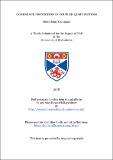Files in this item
Coherence protection in coupled qubit systems
Item metadata
| dc.contributor.advisor | Lovett, Brendon W. | |
| dc.contributor.author | Cammack, Helen Mary | |
| dc.coverage.spatial | [7], vii, 132 p. | en_US |
| dc.date.accessioned | 2018-11-14T15:36:29Z | |
| dc.date.available | 2018-11-14T15:36:29Z | |
| dc.date.issued | 2018-12-06 | |
| dc.identifier.uri | https://hdl.handle.net/10023/16457 | |
| dc.description.abstract | Decoherence is a major barrier to the implementation of quantum technologies. Theoretical techniques for understanding decoherence in composite systems have traditionally been focused on systems with distinguishable emission spectra, where measuring the frequency of an emitted photon allows one to determine which process took place. Here the photon contains information about the state of the system. On the other hand, systems with indistinguishable spectra do not necessarily completely reveal information about the state of the system when a photon is emitted. It can be impossible to say for certain which of two nearly degenerate transitions has occurred just by measuring the photon's frequency. It is then possible to preserve information within the system throughout the decay process. In this Thesis we show that indistinguishable spectra can lead to protected coherences within one part of a coupled quantum system, even as another part decays. We develop a zero-temperature exact approach for modelling such systems, and compare it to the microscopically derived Born-Markov master equation. This comparison helps us to understand the range of validity of the Markovian approximation. We use this understanding to extend the master equation approach to finite temperature within the Markovian regime, and we compare its high temperature results to a semiclassical model. We examine the physical conditions required for coherence protection, and remarkably we find that heating the system can improve coherence protection. Similarly, increasing the decay rate of the unprotected part of the coupled system can also enhance the coherence of the protected part. These effects are the results of linewidth broadening and thus greater spectral indistinguishability. The findings in this Thesis are of interest to both those seeking to engineer hybrid quantum systems and those seeking to develop theoretical techniques for dealing with the decoherence of composite quantum systems. | en_US |
| dc.language.iso | en | en_US |
| dc.publisher | University of St Andrews | |
| dc.subject | Open quantum systems | en_US |
| dc.subject | Quantum information | en_US |
| dc.subject | Hybrid quantum computing | en_US |
| dc.subject | Markovianity | en_US |
| dc.subject | Decoherence | en_US |
| dc.subject | Master equations | en_US |
| dc.subject.lcc | TK7874.885C2 | |
| dc.subject.lcsh | Quantum systems | en |
| dc.subject.lcsh | Quantum computing | en |
| dc.title | Coherence protection in coupled qubit systems | en_US |
| dc.type | Thesis | en_US |
| dc.contributor.sponsor | Engineering and Physical Sciences Research Council (EPSRC) | en_US |
| dc.contributor.sponsor | Scottish Doctoral Training Centre in Condensed Matter Physics (CM-CDT) | en_US |
| dc.type.qualificationlevel | Doctoral | en_US |
| dc.type.qualificationname | PhD Doctor of Philosophy | en_US |
| dc.publisher.institution | The University of St Andrews | en_US |
This item appears in the following Collection(s)
Items in the St Andrews Research Repository are protected by copyright, with all rights reserved, unless otherwise indicated.

